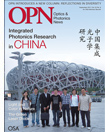
September 2011 Issue
Feature Articles
Integrated Photonics Research in China
Chinese researchers already have a decades-long history of making key contributions to integrated photonics research. Now, with a growing number of research groups and unprecedented government backing, the country is poised to take a leading role in this exciting area, which is a critical driver of global communications technology.
by Andrew W. Poon, Linjie Zhou, Jianping Chen, Yong-Zhen Huang, Jinzhong Yu, Jian-Jun He and Hon K. TsangLight and Color in Nature: A Return to Optics’ Roots
Past OSA President Bob Greenler and OSA Fellow Dave Lynch describe a remarkable conference series in which scientists gather to explore beautiful naked-eye phenomena in the world around us.
by Robert Greenler and David K. LynchThe Green Laser Diode: Completing the Rainbow
Traditionally, green laser diodes have been difficult to construct due to the characteristics of the quantum wells that serve as their gain region. Now, however, several companies and research groups have found ways to fill this “green gap,” by mastering the epitaxy of high-indium-containing quantum wells, balancing strain and defect formation against the quantum-confined Stark effect and using optimized waveguides. Their work is driving new applications in consumer electronics, biophotonics and other areas.
by Ulrich T. Schwarz and Wolfgang G. ScheibenzuberDepartments and Columns
Optics Shine in Wuhan, China
China, the second largest economy in the world, is placing a growing emphasis on the development of science and technology. But behind its booming growth, the country is still rooted in the traditional values of family, respect for the elderly, and education. OSA Fellow Barry Masters describes his recent visit to the city of Wuhan and how the educational system there mixes Chinese traditions with Western infl uences.
Promoting Diversity in Optics: A Column Is Born
OSA Board member Ursula Keller and past president Anthony Johnson are pleased to announce a new space in OPN that will explore how the optics community can broaden its own spectrum.
Managing a Research Group
You worked hard to get your Ph.D.; you went through a few postdoc positions around the world; and now your life’s ambition is fulfilled at last: You get to start or develop your own research group. Are you ready? Sure, you are a seasoned scientist, but how good are you at managing other researchers?
OPN Talks with Sir John Pendry
Our conversation with Sir John Pendry, metamaterials pioneer and Frontiers in Optics keynote speaker.
Single Laser Powers Record Data Transfer Rate
German investigators achieved a transfer rate of 26 Tbits/s over 50 km of single-mode fiber by using a multiplexing technique borrowed from wireless communications.
Memories of an Editor
The son of an iconic JOSA editor reminisces about his father's home-grown operation.
Supporting Science and Building Public Trust
OSA Congressional Fellows share their views on issues at the forefront of Congressional debates.
OPN Talks with Ivan P. Kaminow
Our conversation with Ivan P. Kaminow, 2011 Frederic Ives Medal/Jarus W. Quinn Endowment recipient and FiO plenary speaker.
Broadband Terahertz Cloaking at CLEO:2011
Scientists from two U.S. universities have created a three-dimensional terahertz-spectrum “invisibility cloak” that hides a bump from a wide range of radiation frequencies.
Detecting Skin Cancer in Place
A Duke University researcher described how pump-probe imaging of melanin with near-infrared pulses allowed the researchers to image a developing melanoma directly on the skin.
Graphene Oxide: Oxidation Increases Transparency
Electrical switching can control the optical transparency of thin films of graphene oxide.

![Illustration of a synapse in the brain. [Getty Images]](https://opnmedia.blob.core.windows.net/$web/opn/media/images/articles/2025/0425/departments/202504-cover-web.jpg?ext=.jpg)
![Fiber draped around a hand, demonstrating its flexibility. [Photo by Z. Wang and L. Wei]](https://opnmedia.blob.core.windows.net/$web/opn/media/images/articles/2025/0325/departments/202503-cover-web.jpg?ext=.jpg)
